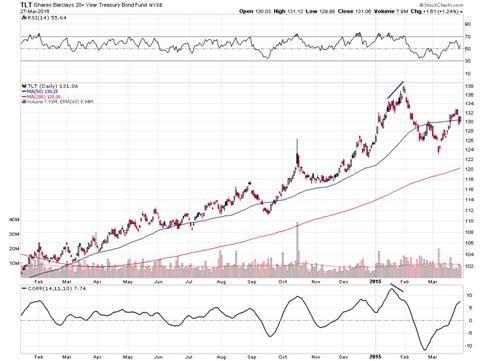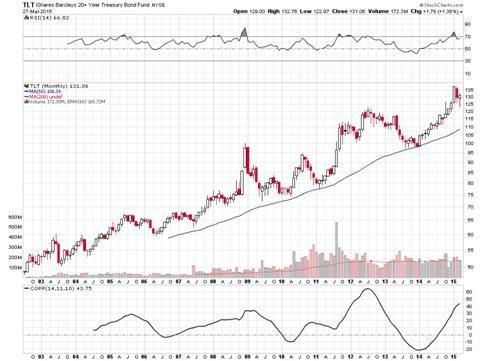by DOUG KASS
From my perch, owning bonds today might be like picking up nickels in front of a steamroller!
I am adding a short U.S. Bond position (short iShares 20+ Year Treasury Bond (TLT) at the Friday closing price of $131.06) as my “Trade of the Week.” I am also, once again, adding long ProShares Short 20+ Year Treasury (TBF) (inverse bond ETF at $23.91) to my Best Ideas List, as I now expect a steady but slow rise in bond yields over the next few years.
I am doing so based on both fundamental, technical and sentiment indicators.
Fundamental: Growth signposts remain weak –- and this is now well known and grounded in consensus. China and Japan are slowing. The U.S. is traveling at a subpar 2% to 2.5% growth rate and, while showing some improving trends, the eurozone is operating at about 1% to 1.5% growth. It is generally recognized that the unbelievably low sovereign debt yields around the world are serving as “gravity” to contribute to lower U.S. rates. While I remain of the view that global growth will be subpar, I suspect that bond prices around the world have now more than discounted this. Moreover, the peripheral yields in Europe likely represent, to me, a parabolic move in bond prices, which are “bubble like” and unlikely to be sustained at such low levels. Should “loss of faith” occur in the ECB and other central bankers, that bubble might quickly burst.
Importantly, over history, 10-year U.S. note yields (currently at 1.95%) have averaged about the same as nominal U.S. GDP growth (real GDP plus inflation). Let’s suppose the following growth rates over the next few years (I am being conservative) — 2.25% real GDP growth plus 1.00% inflation. This would produce nominal GDP growth of 3.25% and (at 1.0x) a 10-year U.S. note yield of a similar level (3.25%), or 140 basis points higher than the current 10-year yield. Even if we adjust for the current gravitational pull of lower sovereign debt yields and structural headwinds to global growth and say that the normal relationship between nominal U.S. GDP growth and 10-year U.S. note yields moves from 1.0x to 0.9x or even 0.8x, this still produces a 10-year U.S. note yield “target” of 2.925% (at 0.9x) or 2.60% (at 0.8x).
In other words, if history rhymes, I can see U.S. Bond yields rising without any material upside revision in economic expectations!
Technical: In life I admire curves, while in technical analysis I admire the Coppock Curve! (Here is a good explanation.) As can be viewed in the charts at the end of this post, TLT reached a price momentum peak and furthest distance from its 200-day moving average back on Jan. 29, 2015. Its overbought Coppock Curve momentum indicator lagged and diverged as the top was made. Since then, TLT corrected by 11% and then had a 67% recovery of that loss before seemingly falling down again. As the Coppock Curve also started to turn well below its prior peak, the possibility exists that bond prices (TLT) are entering into an extended correction time frame. which could be as severe as experienced at similar peaks in December 2008 (that correction lasted two years) and July 2012 (that correction lasted 18 months).
It is my view that a possible correction in bond prices (accompanied by higher yields) could last longer than the 2008 experience given (1) the sustained and near record inflows into bond funds and (2) the near historical low in yield achieved in late January.
Sentiment: As mentioned previously a sustained period of near record inflows into bonds when coupled with a consensus view that interest rates will not (ever!) rise — the opposite of the end of year 2013 consensus — places bonds, as an asset class, as particularly vulnerable to an extreme in bullish sentiment.


NOTE: I expect the rise in interest rates to be slow and gradual over 2015. While I am short bonds against my closed-end municipal bond fund holdings I don’t anticipate that rate rise to disrupt the attraction of municipal funds given the large discount net asset values (6%) and high relative (to Treasuries) and absolute yields (6%).


